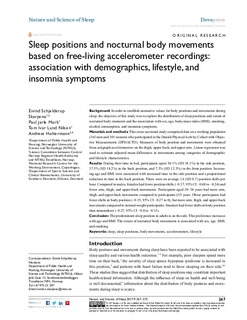| dc.description.abstract | Background: In order to establish normative values for body positions and movements during sleep, the objective of this study was to explore the distribution of sleep positions and extent of nocturnal body moments and the association with sex, age, body-mass index (BMI), smoking, alcohol consumption, and insomnia symptoms.
Materials and methods: This cross-sectional study comprised data on a working population (363 men and 301 women) who participated in the Danish Physical Activity Cohort with Objective Measurements (DPHACTO). Measures of body position and movements were obtained from actigraph accelerometers on the thigh, upper back, and upper arm. Linear regression was used to estimate adjusted mean differences in movements among categories of demographic and lifestyle characteristics.
Results: During their time in bed, participants spent 54.1% (SD 18.1%) in the side position, 37.5% (SD 18.2%) in the back position, and 7.3% (SD 12.3%) in the front position. Increasing age and BMI were associated with increased time in the side position and a proportional reduction in time in the back position. There were on average 1.6 (SD 0.7) position shifts per hour. Compared to males, females had fewer position shifts (–0.37, 95% CI –0.48 to –0.24) and fewer arm, thigh, and upper-back movements. Participants aged 20–34 years had more arm, thigh, and upper-back movements compared to participants ≥35 years. Obese participants had fewer shifts in body position (–0.15, 95% CI –0.27 to 0), but more arm, thigh, and upper-back movements compared to normal-weight participants. Smokers had fewer shifts in body position than nonsmokers (–0.27, 95% CI –0.4 to –0.13).
Conclusion: The predominant sleep position in adults is on the side. This preference increases with age and BMI. The extent of nocturnal body movements is associated with sex, age, BMI, and smoking. | nb_NO |

